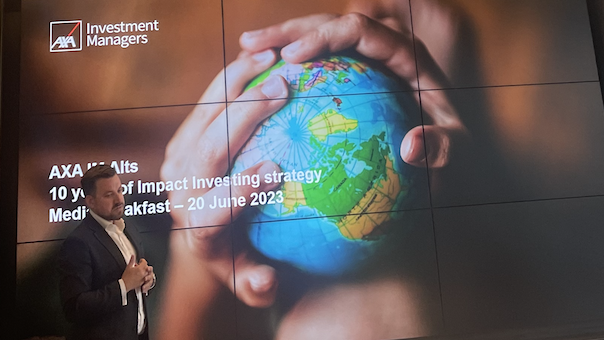
Why the asset owner-manager relationship powers record growth in impact investing
A senior executive at France's AXA IM said institutional investors' appetite for green opportunities makes the impact investing space swell
Some of the key drivers in the rapidly-growing impact investing space are coming through the asset owner relationship with asset managers, according to a leading London manager.
Jonathan Dean, head of fund management for impact private equity at AXA Investment Managers, was speaking at an event marking the release of the AXA IM Alts‘ Impact Investing – Private Markets Annual Review, which revealed that in 2022, 99.2 million tonnes of carbon emissions were avoided and 146.5 million people were empowered through financial inclusion thanks to impact investing strategies.
“Some of the largest asset owners have come to the table in the past decade, using impact as a label to describe their activity”, said Dean.
Adam Gibbon, natural capital lead at AXA IM, said in addition that “there are signals are being sent by the asset owners around what their stakeholders are pushing them towards [on impact] and we need the right frameworks to make this efficient.”
Regarding institutional investors, Shade Duffy, head of impact management at AXA IM, who was also present at the presentation in London, insisted that credibility and transparency are key to winning over this sector.
Duffy stressed developments such as the Sustainable Finance Disclosure Regulation (SFDR) in the EU and Sustainability Disclosure Requirements (SDR) in the UK were ways to achieving this.
Also read
Drastic misalignment in master trust shareholder climate votes at AGMs
Duffy also singled out the development of an impact management tool for AXA IM clients: “Our clients can have access to what our investment committee looks at, and decide if an investment aligns with the impact principles that we espouse. This full transparency can drill down to look at the underlying companies, and targets set at an individual investment level.”
AXA IM were also original signatories of the Operating Principles of Impact Management, the ideals of which will be connected to measurement criteria for the tool.
Some of the largest asset owners have come to the table in the past decade, using impact as a label to describe their activity.
Regulatory developments in impact
SFDR had a rocky introduction, with many Article 9 with the tightening of reporting requirements at the start of the year.
On whether issues with the SFDR rollout has caused greater caution by investors when approaching impact overall, Duffy said: “You now need to show a credential ESG strategy, managing risk and to demonstrate how you're contributing positive social and environmental benefits.
“There were a lot of funds just putting themselves at the highest level. Then we all really realised how serious the regulator was and there was a lot of deregistration, which I think has improved the clarity of the market.”
One Article 9 Fund that AXA IM maintains is the its Global Health Fund. Zina Affas Besse, deputy head of healthcare private equity at the firm, shared data showing that there were returns to be made investing in late-clinical, early commercial stages, and noted that the fund has made investments in areas such as maternal newborn health innovations.
When asked by Net Zero Investor on how AXA IM’s impact division holds up in terms of financial performance compared to wider private markets, Dean noted that this particular fund performed in the uppermost quartile.
AXA as a body also brought attention to its climate goals when it exited the Net-Zero Insurance Alliance earlier this year as US political attacks against the collective organisation intensified.
Last month, Lloyd’s of London became the sixth major insurer to leave the organisation.
On the relationship between this move and the impact division of AXA IM, Dean said: “We can't comment on the group position but in terms of how we see it from an investment strategy, we still see the same opportunities, we still see the same funding gaps, we still see the same inequality gaps and if we compare that with delivering attractive returns, we will navigate that space accordingly.”
In February this year AXA IM confirmed that Nigel Topping, a policy adviser and former Climate Champion for COP26, will provide the firm with advice on climate and share his expertise and insights on a range of topics, including macroeconomics, climate change, biodiversity and natural resources.
Also read
Pension funds spot fresh investment opportunities in renewables




